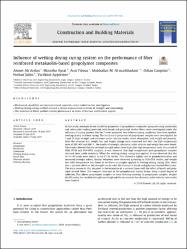Influence of wetting-drying curing system on the performance of fiber reinforced metakaolin-based geopolymer composites

Göster/
Tarih
2019Yazar
Arslan, Ahmet AliUysal, Mücteba
Yılmaz, Arın
Al-Mashhadani, Mukhallad M.
Canpolat, Orhan
Şahin, Furkan
Aygörmez, Yurdakul
Üst veri
Tüm öğe kaydını gösterÖzet
In this study, mechanical and durability properties of geopolymer composites prepared using metakaolin
and colemanite binding materials with basalt and polyvinyl alcohol fibers were investigated under the
influence of curing systems. For the 7 series prepared, two different curing conditions have been applied:
wetting-drying and heat curing. The mechanical properties of geopolymer samples were investigated for
7 and 28 days strength and ultrasonic pulse velocity results, water absorption, unit weight and porosity.
After the abrasion test, weight loss and length change were examined and after the high temperature
tests of 200, 400 and 600 C, the results of strength, ultrasonic pulse velocity and weight loss were found.
The results showed that the residual strength values were high after high temperature tests. As a result of
SEM, FT-IR and TGA-DTA analyzes, it was observed that high temperature post-geopolymer samples
retained their stable structure. When the wetting-drying curing was applied, it was observed that the
SiAOAAl bonds were higher in the FT-IR results. This showed a higher rate of geopolymerization and
increased strength values. Similar behaviors were observed according to TGA-DTA results, and weight
loss with temperature was found to be lower in samples applied to wetting-drying curing. Also, there
was a positive effect on the strength results with the increase in basalt and polyvinyl alcohol fibers ratio.
The main reason for this situation is the formation of a resistant layer with the effect of basalt and polyvinyl alcohol fibers. The compact structure of the geopolymeric matrix brings along a good degree of
adhesion. This allows geopolymer samples to resist freezing-thawing. In geopolymer samples, despite
the 90 cycles, the residual strength were high and the decrease in the ultrasonic pulse velocity rate results
were limited.
















